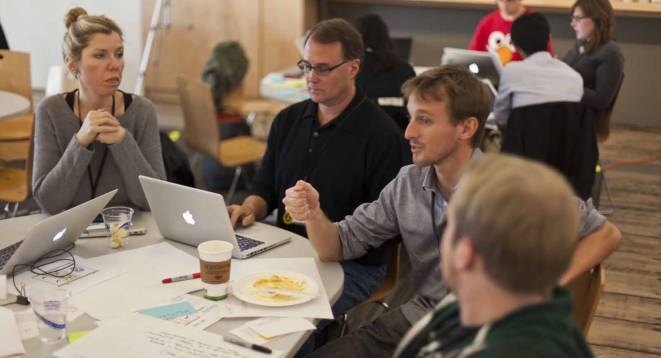Hack-a-thon fights flies and faeces in Ghana

Since 1999, hack-a-thons have brought programmers and other software developers together to collaborate intensely on a software project over a short period of time – typically two to five days.
But hack-a-thons aren’t just for techies these days. In November, the social entrepreneurs at IDEO.org and Water and Sanitation for the Urban Poor (WSUP) gathered sanitation experts, designers, storytellers, coders, reformed engineers, and folks with knowledge of Ghana to help them design a way to empower residents to fight open defecation in their neighborhoods.
Dubbed the “crap map” project, approximately 50 folks gathered to talk $hit, to brainstorm potential strategies that could lead to improved health and sanitation in Kumasi, an urban area of Ghana. Funded in part by USAID, this project took as its point of departure the Community Led Total Sanitation (CLTS) approach that has worked effectively in rural environments.
Participants learned that more people have access to mobile phones than toilets in much of the developing world, and the creative folks at IDEO.org and WSUP spoke briefly about cultural norms in Kumasi, and how the CLTS strategies have worked in the past. In rural community work, trainers demonstrate to villagers how flies travel from a plate of faeces to a plate of food and what that means for health.
But with the challenges of urban neighborhoods, how can similar communications vehicles be successful? That’s the problem hackers were attempting to solve.
Over the course of the two workdays, participants split into teams arranged so that various skill sets were present in each group. Laptops were wielded and sticky notes quickly filled whiteboards while groups addressed the following:
- Collect: How might we gather information about open defecation?
- Understand: How do we present open defecation in a way that drives action?
- Act: What action do people undertake against open defecation...
- In order to Achieve an open defecation-free neighborhood reached through collective action.
The prototype that emerged at the end of all this intense thinking combined a digital mobile platform with offline community-driven activities. The comms group created for the hack-a-thon dubbed it “Clean Kumasi”. According to Molly Norris of IDEO.org, “Our concept centers on tracking the cleanliness of community landmarks in Kumasi, such as schools, churches and water sources.”
In Kumasi, the field team worked with community and student groups to identify important landmarks to the community. Posters placed on site ask local residents to text information about open defecation at those landmarks. The data collected uploads to a map and on Facebook pages for each landmark.
The hope is that this process will mobilize a group of self-selected community members who want to see these landmarks clean and waste free. The organizers suspect that the social networking that ensues will trigger face-to-face community meetings where facilitators can galvanize grassroots action to create solutions for this vexing problem. This could result in citizens pressuring government or the private sector to improve sanitation. Implicit in this process is room for residents to self-organize and collaborate on solutions that will make the most sense to their community.
There's a film of the hack-a-thon here.
And you can learn more about the ongoing project – how the prototype is working out and meet the social change agents in the field here.
